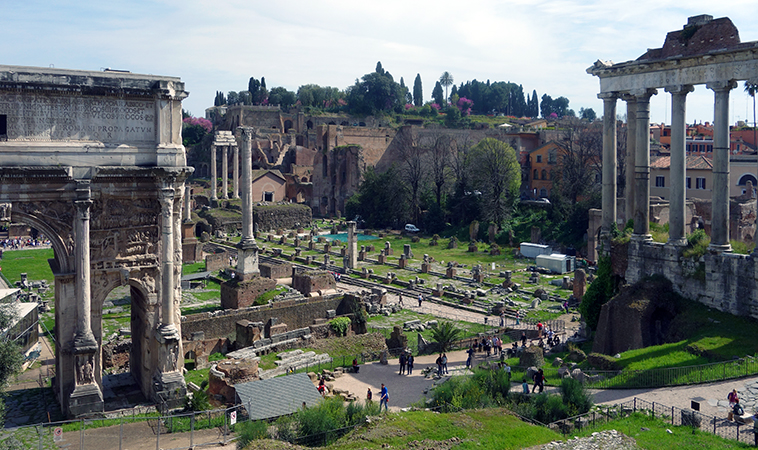In his play Curculio, the Latin playwright Plautus offers perhaps one of the most comprehensive and insightful descriptions of the Forum Romanum ever written (ll. 466-482). In his summary, Plautus gives the reader the sense that one could find just about every sort of person in the forum—from criminals and hustlers to politicians and prostitutes. His summary reminds us that in the city of Rome the Forum Romanum was the key political, ritual, and civic center. Located in a valley separating the Capitoline and Palatine Hills, the Forum developed from the earliest times and remained in use after the city’s eventual decline; during that span of time the forum witnessed the growth and eventual contraction of the city and her empire. The archaeological remains of the Forum Romanum itself continue to provide important insights into the phases and processes associated with urbanism and monumentality in ancient Rome.
Earliest history: from necropolis to civic space
Situated astride the Tiber river, the site of Rome is noted for its low hills that are separated by deeply cut valleys. The hilltops became the focus of settlement beginning in the Early Iron Age; the development of the settlement continued during the first millennium B.C.E., with the traditional Roman account holding that the city herself was founded in 753 B.C.E. (Livy 1.6)
Addressing the problems of seasonal rains and flooding proved more challenging—the valley required a landfill project as well as the construction of a drainage canal to manage standing water. Since the Tiber river tended to leave its banks regularly, the valley was prone to significant flooding, as a low saddle of land known as the Velabrum connects the forum valley to the riverine zone. As coring studies conducted by Albert J. Ammerman have shown, a deliberate landfill project deposited fill in the forum valley in order to create usable, dry levels during the sixth century B.C.E. Twentieth century excavators, including Giacomo Boni and Einar Gjerstad, revealed important remains of Iron Age burials that pre-dated the establishment of the forum valley as a civic space; in particular the necropolis in the area known as the Sepulcretum along the Sacra Via (“Sacred Way,” the main sacred processional road of the city) has been extensively studied and published. The investigations of the burials themselves, and the patterns they followed, have allowed archaeologists to understand not only funeral customs but also social dynamics during Rome’s proto-urban phases.
Temples and sacred buildings
Two other early, sacred buildings are important to note. These are the Regia or “king’s house” and the Temple of Vesta, both located on the downward slope of the Palatine Hill near the point where it reaches the edge of the Forum Romanum proper. Both of these sacred buildings are quite ancient and had many building phases, making it difficult to refine the chronology of the earliest phases. The Regia served as a ceremonial home for the king—later passing into the ownership of the pontifex maximus (principal state-level priesthood) once the kings had been expelled—and consisted of an irregularly planned suite of rooms surrounding a courtyard. The sixth century B.C.E. phase was decorated with painted plaques of architectural terracotta, clearly indicating both elite function and investment. Across the way was the Temple of Vesta, focused on the maternal elements of the archaic state as well as safeguarding the cult of Vesta and the sacred, eternal hearth flame of the Roman people. Both the Regia and the Temple of Vesta developed from crude structures in earlier phases to stone-built architecture in later phases. The Severan family carried out the final significant restoration of the Temple of Vesta in 191 C.E.
Meeting spaces
From Republic to Empire
The Basilica
Imperial period
Coming to power at the end of the second century C.E., the Severan family erected a triple-bay triumphal arch commemorating the victories of emperor Septimius Severus (reigned 193-211 C.E.) at the northwestern corner of the forum square. The third century C.E. saw rebuilding of structures and monuments that had been damaged by fire, including the rebuilding of the Curia Julia by the emperor Diocletian in the late third century C.E. following a fire in 283 C.E.
Decline
The beauty of the ruins
Interpretation
Rediscovery and excavation
Candela Citations
- Forum Romanum (The Roman Forum). Authored by: Dr. Jeffrey A. Becker. Provided by: Khan Academy. Located at: https://www.khanacademy.org/humanities/ancient-art-civilizations/roman/beginners-guide-rome/a/forum-romanum-the-roman-forum. Project: Forum Romanum (The Roman Forum). License: CC BY-NC-SA: Attribution-NonCommercial-ShareAlike













